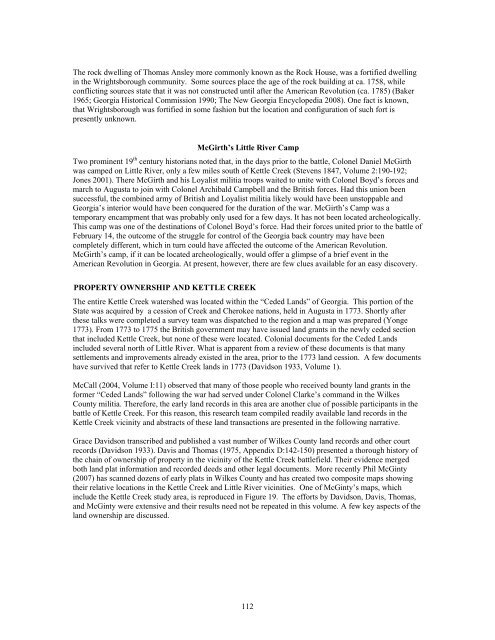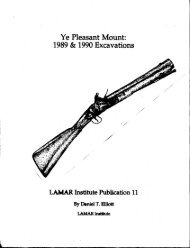Stirring Up a Hornet's Nest: - UGA Laboratory of Archaeology ...
Stirring Up a Hornet's Nest: - UGA Laboratory of Archaeology ...
Stirring Up a Hornet's Nest: - UGA Laboratory of Archaeology ...
You also want an ePaper? Increase the reach of your titles
YUMPU automatically turns print PDFs into web optimized ePapers that Google loves.
The rock dwelling <strong>of</strong> Thomas Ansley more commonly known as the Rock House, was a fortified dwelling<br />
in the Wrightsborough community. Some sources place the age <strong>of</strong> the rock building at ca. 1758, while<br />
conflicting sources state that it was not constructed until after the American Revolution (ca. 1785) (Baker<br />
1965; Georgia Historical Commission 1990; The New Georgia Encyclopedia 2008). One fact is known,<br />
that Wrightsborough was fortified in some fashion but the location and configuration <strong>of</strong> such fort is<br />
presently unknown.<br />
McGirth’s Little River Camp<br />
Two prominent 19 th century historians noted that, in the days prior to the battle, Colonel Daniel McGirth<br />
was camped on Little River, only a few miles south <strong>of</strong> Kettle Creek (Stevens 1847, Volume 2:190-192;<br />
Jones 2001). There McGirth and his Loyalist militia troops waited to unite with Colonel Boyd’s forces and<br />
march to Augusta to join with Colonel Archibald Campbell and the British forces. Had this union been<br />
successful, the combined army <strong>of</strong> British and Loyalist militia likely would have been unstoppable and<br />
Georgia’s interior would have been conquered for the duration <strong>of</strong> the war. McGirth’s Camp was a<br />
temporary encampment that was probably only used for a few days. It has not been located archeologically.<br />
This camp was one <strong>of</strong> the destinations <strong>of</strong> Colonel Boyd’s force. Had their forces united prior to the battle <strong>of</strong><br />
February 14, the outcome <strong>of</strong> the struggle for control <strong>of</strong> the Georgia back country may have been<br />
completely different, which in turn could have affected the outcome <strong>of</strong> the American Revolution.<br />
McGirth’s camp, if it can be located archeologically, would <strong>of</strong>fer a glimpse <strong>of</strong> a brief event in the<br />
American Revolution in Georgia. At present, however, there are few clues available for an easy discovery.<br />
BPROPERTY OWNERSHIP AND KETTLE CREEK<br />
The entire Kettle Creek watershed was located within the “Ceded Lands” <strong>of</strong> Georgia. This portion <strong>of</strong> the<br />
State was acquired by a cession <strong>of</strong> Creek and Cherokee nations, held in Augusta in 1773. Shortly after<br />
these talks were completed a survey team was dispatched to the region and a map was prepared (Yonge<br />
1773). From 1773 to 1775 the British government may have issued land grants in the newly ceded section<br />
that included Kettle Creek, but none <strong>of</strong> these were located. Colonial documents for the Ceded Lands<br />
included several north <strong>of</strong> Little River. What is apparent from a review <strong>of</strong> these documents is that many<br />
settlements and improvements already existed in the area, prior to the 1773 land cession. A few documents<br />
have survived that refer to Kettle Creek lands in 1773 (Davidson 1933, Volume 1).<br />
McCall (2004, Volume I:11) observed that many <strong>of</strong> those people who received bounty land grants in the<br />
former “Ceded Lands” following the war had served under Colonel Clarke’s command in the Wilkes<br />
County militia. Therefore, the early land records in this area are another clue <strong>of</strong> possible participants in the<br />
battle <strong>of</strong> Kettle Creek. For this reason, this research team compiled readily available land records in the<br />
Kettle Creek vicinity and abstracts <strong>of</strong> these land transactions are presented in the following narrative.<br />
Grace Davidson transcribed and published a vast number <strong>of</strong> Wilkes County land records and other court<br />
records (Davidson 1933). Davis and Thomas (1975, Appendix D:142-150) presented a thorough history <strong>of</strong><br />
the chain <strong>of</strong> ownership <strong>of</strong> property in the vicinity <strong>of</strong> the Kettle Creek battlefield. Their evidence merged<br />
both land plat information and recorded deeds and other legal documents. More recently Phil McGinty<br />
(2007) has scanned dozens <strong>of</strong> early plats in Wilkes County and has created two composite maps showing<br />
their relative locations in the Kettle Creek and Little River vicinities. One <strong>of</strong> McGinty’s maps, which<br />
include the Kettle Creek study area, is reproduced in Figure 19. The efforts by Davidson, Davis, Thomas,<br />
and McGinty were extensive and their results need not be repeated in this volume. A few key aspects <strong>of</strong> the<br />
land ownership are discussed.<br />
112










